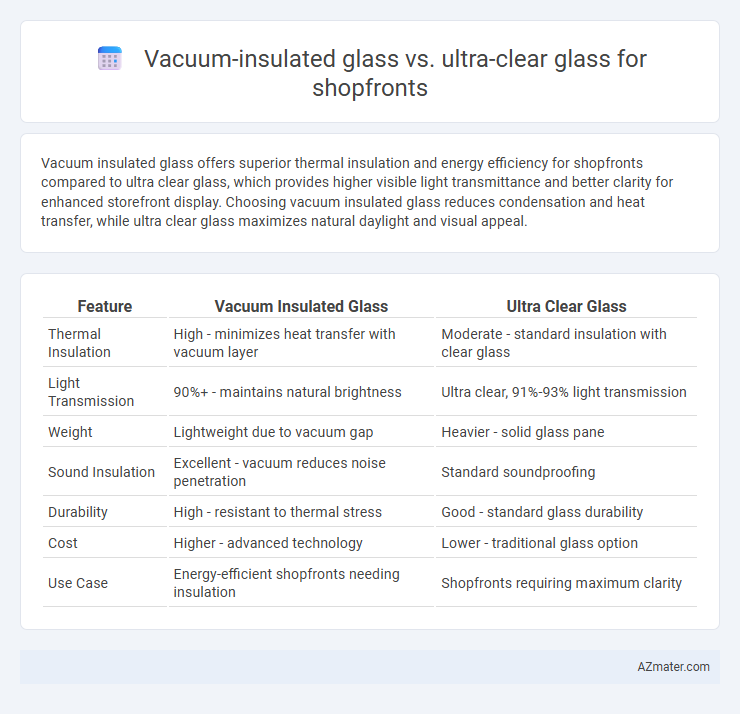Vacuum insulated glass offers superior thermal insulation and energy efficiency for shopfronts compared to ultra clear glass, which provides higher visible light transmittance and better clarity for enhanced storefront display. Choosing vacuum insulated glass reduces condensation and heat transfer, while ultra clear glass maximizes natural daylight and visual appeal.
Table of Comparison
| Feature | Vacuum Insulated Glass | Ultra Clear Glass |
|---|---|---|
| Thermal Insulation | High - minimizes heat transfer with vacuum layer | Moderate - standard insulation with clear glass |
| Light Transmission | 90%+ - maintains natural brightness | Ultra clear, 91%-93% light transmission |
| Weight | Lightweight due to vacuum gap | Heavier - solid glass pane |
| Sound Insulation | Excellent - vacuum reduces noise penetration | Standard soundproofing |
| Durability | High - resistant to thermal stress | Good - standard glass durability |
| Cost | Higher - advanced technology | Lower - traditional glass option |
| Use Case | Energy-efficient shopfronts needing insulation | Shopfronts requiring maximum clarity |
Introduction to Shopfront Glass Options
Vacuum insulated glass offers superior thermal insulation by minimizing heat transfer, making it ideal for energy-efficient shopfronts in varying climates. Ultra clear glass maximizes visibility and natural light transmission with minimal greenish tint, enhancing product displays and customer engagement. Choosing between these options depends on priorities like energy savings versus optical clarity, both critical factors for modern retail facades.
What is Vacuum Insulated Glass?
Vacuum insulated glass (VIG) consists of two glass panes separated by a vacuum space, eliminating air and significantly reducing heat transfer for superior thermal insulation in shopfronts. This technology enhances energy efficiency by minimizing heat loss and condensation, making it ideal for maintaining indoor comfort in commercial buildings. Compared to ultra clear glass, VIG offers better insulation performance while still providing high visible light transmission and clarity.
Understanding Ultra Clear Glass
Ultra clear glass offers superior light transmission and minimal color distortion compared to vacuum insulated glass, making it ideal for shopfronts that prioritize visual clarity and aesthetic appeal. Its low iron content reduces the greenish tint typical of standard glass, enhancing product visibility and creating a more inviting storefront. While vacuum insulated glass excels in thermal insulation, ultra clear glass provides a crisp, true-to-color view that significantly improves customer experience and storefront presentation.
Thermal Performance Comparison
Vacuum insulated glass (VIG) offers superior thermal performance compared to ultra clear glass for shopfronts, with U-values as low as 0.5 W/m2K, significantly reducing heat transfer and improving energy efficiency. Ultra clear glass typically has a U-value around 5.8 W/m2K, allowing more heat loss and gain due to its standard double glazing without vacuum insulation. By minimizing conduction and convection within the vacuum space, VIG enhances temperature regulation and lowers heating and cooling costs in commercial storefront applications.
Energy Efficiency Benefits
Vacuum insulated glass offers superior energy efficiency for shopfronts by minimizing heat transfer through its near-vacuum core, reducing thermal bridges, and significantly lowering heating and cooling costs. Ultra clear glass enhances energy performance by maximizing visible light transmission while minimizing infrared and ultraviolet radiation, contributing to natural daylighting and reduced reliance on artificial lighting. Both technologies support energy savings, but vacuum insulated glass provides greater insulation performance, making it ideal for environments with extreme temperature variations.
Aesthetic Appeal and Transparency
Vacuum insulated glass offers superior clarity with minimal distortion, enhancing the aesthetic appeal of shopfronts through its sleek, modern look and excellent transparency. Ultra clear glass features higher light transmittance and reduced green tint compared to standard glass, providing vibrant, true-to-life colors and sharp visual access to displays. Both options elevate shopfront aesthetics, but vacuum insulated glass provides added thermal performance without compromising the visual experience.
Durability and Maintenance
Vacuum insulated glass offers superior durability for shopfronts by preventing condensation and minimizing thermal stress, resulting in long-lasting clarity and structural integrity. Ultra clear glass, while visually appealing due to higher light transmission, may require more frequent cleaning and maintenance to retain its pristine appearance, as it is more prone to surface scratches and environmental residue. Businesses prioritizing low maintenance and robust performance often prefer vacuum insulated glass for its enhanced resistance to weathering and reduced energy costs.
Cost Analysis: Vacuum Insulated vs Ultra Clear Glass
Vacuum insulated glass generally costs significantly more than ultra clear glass due to its advanced technology and superior thermal insulation properties. Ultra clear glass offers a more budget-friendly option while providing excellent optical clarity and decent energy efficiency, making it suitable for standard shopfront installations. Cost analysis indicates that while vacuum insulated glass entails higher upfront investment, it delivers long-term savings through reduced energy expenses and enhanced durability, potentially offsetting initial costs over time.
Security and Safety Considerations
Vacuum insulated glass offers enhanced security for shopfronts due to its multi-layer construction that resists breakage and provides better impact resistance compared to ultra clear glass. Ultra clear glass, while aesthetically pleasing with high light transmission, typically lacks the robust strength required to withstand forced entry or accidental impacts. For safety-conscious retail environments, vacuum insulated glass significantly reduces the risk of injury and improves protection against vandalism and burglary attempts.
Choosing the Right Glass for Your Shopfront
Vacuum insulated glass offers superior thermal insulation and energy efficiency for shopfronts, reducing heat transfer and minimizing condensation while maintaining clear visibility. Ultra clear glass provides higher light transmission and enhanced optical clarity, making it ideal for showcasing products with vibrant colors and true-to-life details. Selecting the right glass depends on balancing energy performance needs with aesthetic goals to enhance customer experience and operational costs.

Infographic: Vacuum insulated glass vs Ultra clear glass for Shopfront
 azmater.com
azmater.com